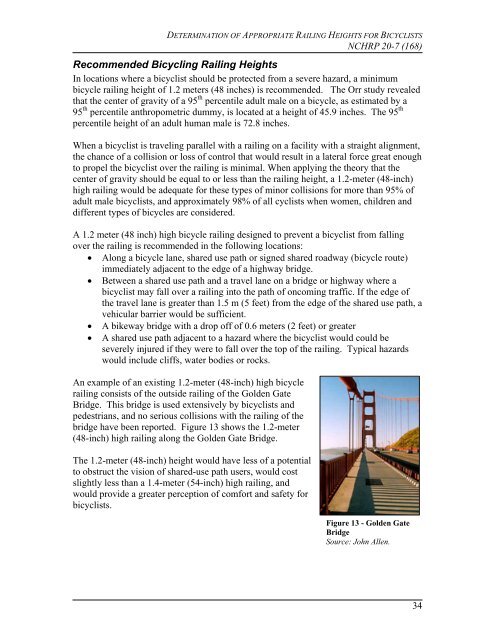Bicycle Railing Height Report - AASHTO - Subcommittee on Design
Bicycle Railing Height Report - AASHTO - Subcommittee on Design
Bicycle Railing Height Report - AASHTO - Subcommittee on Design
You also want an ePaper? Increase the reach of your titles
YUMPU automatically turns print PDFs into web optimized ePapers that Google loves.
DETERMINATION OF APPROPRIATE RAILING HEIGHTS FOR BICYCLISTS<br />
NCHRP 20-7 (168)<br />
Recommended Bicycling <str<strong>on</strong>g>Railing</str<strong>on</strong>g> <str<strong>on</strong>g>Height</str<strong>on</strong>g>s<br />
In locati<strong>on</strong>s where a bicyclist should be protected from a severe hazard, a minimum<br />
bicycle railing height of 1.2 meters (48 inches) is recommended. The Orr study revealed<br />
that the center of gravity of a 95 th percentile adult male <strong>on</strong> a bicycle, as estimated by a<br />
95 th percentile anthropometric dummy, is located at a height of 45.9 inches. The 95 th<br />
percentile height of an adult human male is 72.8 inches.<br />
When a bicyclist is traveling parallel with a railing <strong>on</strong> a facility with a straight alignment,<br />
the chance of a collisi<strong>on</strong> or loss of c<strong>on</strong>trol that would result in a lateral force great enough<br />
to propel the bicyclist over the railing is minimal. When applying the theory that the<br />
center of gravity should be equal to or less than the railing height, a 1.2-meter (48-inch)<br />
high railing would be adequate for these types of minor collisi<strong>on</strong>s for more than 95% of<br />
adult male bicyclists, and approximately 98% of all cyclists when women, children and<br />
different types of bicycles are c<strong>on</strong>sidered.<br />
A 1.2 meter (48 inch) high bicycle railing designed to prevent a bicyclist from falling<br />
over the railing is recommended in the following locati<strong>on</strong>s:<br />
• Al<strong>on</strong>g a bicycle lane, shared use path or signed shared roadway (bicycle route)<br />
immediately adjacent to the edge of a highway bridge.<br />
• Between a shared use path and a travel lane <strong>on</strong> a bridge or highway where a<br />
bicyclist may fall over a railing into the path of <strong>on</strong>coming traffic. If the edge of<br />
the travel lane is greater than 1.5 m (5 feet) from the edge of the shared use path, a<br />
vehicular barrier would be sufficient.<br />
• A bikeway bridge with a drop off of 0.6 meters (2 feet) or greater<br />
• A shared use path adjacent to a hazard where the bicyclist would could be<br />
severely injured if they were to fall over the top of the railing. Typical hazards<br />
would include cliffs, water bodies or rocks.<br />
An example of an existing 1.2-meter (48-inch) high bicycle<br />
railing c<strong>on</strong>sists of the outside railing of the Golden Gate<br />
Bridge. This bridge is used extensively by bicyclists and<br />
pedestrians, and no serious collisi<strong>on</strong>s with the railing of the<br />
bridge have been reported. Figure 13 shows the 1.2-meter<br />
(48-inch) high railing al<strong>on</strong>g the Golden Gate Bridge.<br />
The 1.2-meter (48-inch) height would have less of a potential<br />
to obstruct the visi<strong>on</strong> of shared-use path users, would cost<br />
slightly less than a 1.4-meter (54-inch) high railing, and<br />
would provide a greater percepti<strong>on</strong> of comfort and safety for<br />
bicyclists.<br />
Figure 13 - Golden Gate<br />
Bridge<br />
Source: John Allen.<br />
34


